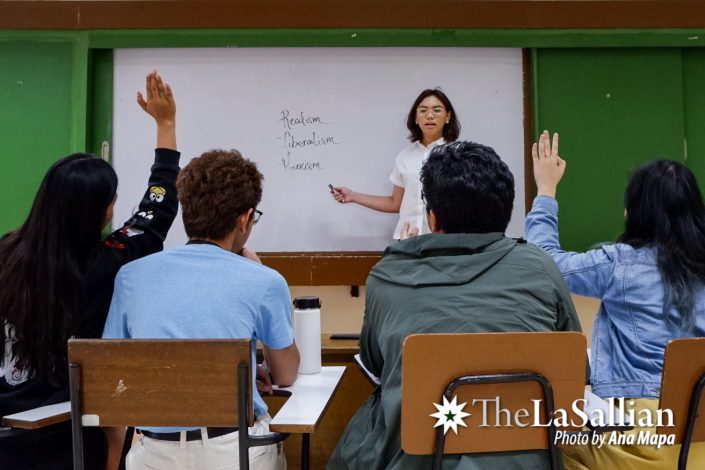In a world where an opinion is never a finite resource, educators who can help guide and develop the way the youth thinks—without tainting or manipulating them to submit to personal biases—are crucial in every classroom. The interactions shared between teacher and student may not always result in complete intellectual alignment, but they are part and parcel of creating an avenue for sparking conversations about difficult topics. Through this, the classroom can evolve into a space for deep and meaningful discourse tackling varying perspectives, including delving into often controversial sociopolitical issues.
Balanced, as all things should be
When asked about having a set of formulas when teaching politics, International Studies Department Associate Professor Elaine Tolentino responds with a straightforward “I don’t.”
Tolentino points out that teaching isn’t as absolute and archaic as one might think. For exploring political issues specifically, an educator has to take into account all possible factors during the discussion, including the room, the students, the environment, and the current social issues relevant to a given context.
The student-teacher dynamic is especially crucial to the success of these dialogues, with Tolentino declaring that establishing the right classroom environment is no easy task. This is where an educator’s flexibility comes in. Every discussion is its own beast—a hurdle that every teacher must learn to overcome. As such, Tolentino emphasizes the need to be versatile and sensitive toward her students. “I have to get a feel of what the class is like,” she explains.
In some cases, these political issues can even be used as examples to better understand the concepts, theories, and schools of thought discussed in class. Topin Ruiz, a lecturer from the Political Science Department, indicates the importance of including discussions about such issues in class. “I use political issues so that students would be able to contextualize what they have learned from classes and books…into real-life experiences and issues in the country and the world today,” she affirms.
Despite the challenges of guiding young minds and framing a certain discussion, Tolentino identifies what drives her to tackle and teach difficult topics: “My inspiration is for students [to] at least be made aware of these things—[that] they do not seem to live in a vacuum—and with [this] awareness comes a more critical view of the world.”

Agree to disagree
As with any dialogue, and for political discussions most especially, clashing viewpoints often arise. The goal of these discussions, however, is not to create a hive mind but to foster a generation of critical thinkers. “Students are entitled to their perspective. I think what’s more important is that we respect each other’s opinion,” Tolentino explains.
This does not mean all opinions are sound, however, as these viewpoints are often limited by the knowledge one has about the issue. “Experiences dictate what your politics is,” Tolentino points out.
A valid argument must be backed up by facts and relevant evidence, as well as should be structured by logical reasoning. As such, Ruiz makes it a point to always discuss the pertinent information surrounding an issue before opening the discussion to the students. “This is a rule in my class—they can only talk about their opinions on things they [fully] understand. Otherwise, they should be open to hearing things they need to know first,” she stresses.
Even when equipped with the same background information, it is inevitable for individuals to debate about a topic. Any sort of discussion remains complex due to each individual’s distinct schema, and perspectives cannot escape being tangled with personal biases. To address this, identifying the theories and ideologies underlying every opinion is necessary. “These frameworks are laid out to them so that they are aware of why there are differing opinions and positions in class,” discusses Ruiz.
Tolentino similarly notes that the discourse surrounding these topics must remain open to several viewpoints to “give [students] different perspectives” that they can ponder and evaluate. “Instead of injecting your own biases, you use questions, and let them figure it out for themselves,” she suggests, preferring such an approach as she also acknowledges that she has her limitations. She furthers, “I [have] never told my students that I’m an expert [all the time]—I never say that in class, because I’m not. I’m learning while [they’re] learning.”
An invitation for dialogue
Political issues can be a polarizing topic, which is why having a platform where everyone can freely converse and compare viewpoints is integral to deepen the understanding of such issues. It may be close to impossible for everyone to completely agree on a single thing, but the key is not to form an absolute consensus. Instead, the teacher’s goal is to provide a space where the youth can express and refine their opinions and, in the process, maintain an open-mindedness that allows them to consider a variety of perspectives.
“Discussing polarizing topics [is] essential to teaching critical thinking and tolerance. Political issues are tackled…to equip [the students to come] up with their [own] stand and opinions that are critical and sound,” Ruiz remarks.
Tolentino similarly believes that educators should aim to provide a conducive space for exploring these issues. “Basta, pag–ka may nakuha iyong estudyante kahit one to two key points—that’s more than enough,” she emphasizes that not everything can be learned in the classroom, especially with the plethora of new information emerging each day.
(As long as the student internalizes one to two key points.)
Teaching thus becomes more about equipping students to be independent thinkers beyond their formal education, as Tolentino concludes, “At the end of the day, [the faculty] should allow students to form their own ideas because that is learning.”
